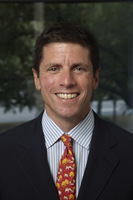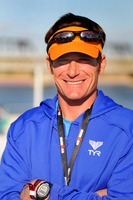|
Press
|
|
By Mark Klion and Troy Jacobson
ISBN: 978-1-4504-2138-6
Binding: Paperback
Pages: Approx. 200
Price: $21.95
Available: December 2012
CHAMPAIGN, IL—Triathletes undergo extensive training to develop the cardiorespiratory endurance necessary for withstanding the rigors of triathlon. But according to Mark Klion, an orthopedic surgeon and 10-time Ironman participant, a successful training program must also incorporate strength and flexibility training. “The goal of a program should be to promote musculoskeletal health and improve the body’s ability to withstand the repetitive stresses placed on it by endurance activities,” Klion explains. “Unlike many other sports such as football or soccer, triathlons require tolerance to prolonged exercise.”
In the forthcoming Triathlon Anatomy (Human Kinetics, December 2012), Klion and triathlon coach Troy Jacobson offer over 80 exercises, depicted by full-color anatomical illustrations, for developing the muscles essential for swimming, biking, and running. “The development of strength with sport-specific exercise improves economy of motion, or the ease with which you perform an activity,” Klion says. “This will help you go faster and decrease stress on the body.”
“Athletes should perform sport-specific training before strength work in order to ensure good form and enable solid development of technique,” Klion says. “Muscles that are tired because of resistance training can foster poor movement patterns when swimming and running, thereby impeding efficiency and wasting energy.”
Each discipline in a triathlon requires a coordinated pattern of muscle recruitment that produces motion about the joints and creates the power to make the triathlete move. “As a triathlete transitions from one discipline to the next, a concomitant increase in weight-bearing activity is seen,” Klion says. “Running, the greatest weight-bearing activity of the three, places the most impact on the body and requires a smooth coordination between upper and lower extremities to enable efficient gait.” Klion notes that strength training with both isolated and sport-specific exercises will help develop a strong foundation to create power and speed and also prevent injury.
“Triathletes often like to say, ‘The larger the engine, the faster the train,’” Klion says. “A fast engine that breaks down frequently from overtraining can be problematic and frustrating. A well-thought-out training program that includes strength and flexibility training can create a large engine that runs smoothly. Train smart and stay healthy.”
For more information, see Triathlon Anatomy. 
|

|
|
Mark Klion, MD, is a board-certified orthopedic surgeon and sports medicine specialist. After receiving a bachelor’s degree from St. Lawrence University in upstate New York, he earned his medical degree from the Mount Sinai School of Medicine in New York City. He completed his residency in orthopedic surgery at Mount Sinai Hospital. He then completed a sports medicine fellowship at the University of Chicago. During his fellowship he specialized in arthroscopic surgery and reconstructive knee and shoulder surgery. He is a clinical instructor at the Mount Sinai School of Medicine and a member of their shoulder and sports medicine service. He serves as an educator for the medical school and the department of orthopedic surgery. He is also the director of orthopedics at St. Barnabas Hospital in New York. He performs the newest techniques for cartilage repair, regeneration, and meniscal transplantation. Dr. Klion has extensive experience with arthroscopic rotator cuff repairs and shoulder stabilization procedures.
Dr. Klion is also an avid triathlete and marathon runner. He has completed 10 Ironman triathlons, including Hawaii Ironmans in 2000 and 2001. He has completed 15 marathons and several ultradistance races. He created the DVD series BodyworksMD, a physician-guided physical therapy rehabilitation program. He serves as the medical codirector for the New York City Triathlon and Toughman Half Ironman and is the orthopedic consultant for the Triathlon Academy and Foundation bicycle team.
Troy Jacobson has been a leader in the field of triathlon coaching since 1992. He is the owner of Lifesports, Inc., an endurance multisport coaching company, and is recognized as a pioneer in developing and marketing online coaching services. He is the innovator and driving force behind the popular endurance sport training DVD Spinervals Cycling and founded the National Triathlon Academy in 2000. He created Train Right software, an intuitive coaching program chosen as the official software of Tri-Fed USA in the mid 1990s.
When Tri-Fed became USA Triathlon, Jacobson became a member of the inaugural USA Triathlon coaching committee. A personal coach to athletes of all abilities from age groupers to a former U.S. Olympian, Jacobson served as the official coach of Ironman from 2010 through 2012 and held the position of head triathlon coach at Life Time Fitness, Inc., a publicly traded national health club chain.
Jacobson has been a competitive triathlete since 1988 and continues to compete at the elite masters level. In the 1990s he became a professional triathlete, winning several USA Triathlon Long Course National Championships and placing as high as 20th overall at the Ironman Triathlon World Championships. For more information, visit his Web site at www.coachtroy.com.
Chapter 1 The Triathlete in Motion
Chapter 2 Cardio Training
Chapter 3 Creating a Customized Training Plan
Chapter 4 Arms
Chapter 5 Shoulders
Chapter 6 Chest
Chapter 7 Core
Chapter 8 Back and Neck
Chapter 9 Legs
Chapter 10 Whole Body Training
Chapter 11 Injury Prevention

|
 Mark Klion |

 Troy Jacobson |

|
"Troy Jacobson has been at the forefront of coaching athletes of all levels for more than 20 years. Triathlon Anatomy reflects his coaching philosophy, which has generated as much success for his clients as any coach in our sport."
Kevin O’Connor
Owner of Gear West Bike & Triathlon
Six-Time Ironman Hawaii Athlete (9:13 Kona PR)
2009 USAT Overall Duathlete of the Year
“Triathlon Anatomy is packed with exercises and advice to help multisport athletes perform better and stay injury free. Whether you’re a weekend warrior or an Ironman veteran, Triathlon Anatomy should be in your training library.”
Jonathan Cane
Cofounder of City Coach Multisport
Nike RunningCoach
“In Triathlon Anatomy, Mark Klion and Troy Jacobson help triathletes get the most out of their strength training workouts while avoiding injury. The book is an essential resource for anyone striving for multisport success.”
Lee Silverman
Owner of JackRabbit Sports
- Triathlon is considered by some to have its beginnings in France in the 1920s. The first modern swim, bike, run event to be called a triathlon was held at Mission Bay, San Diego, California, on September 25, 1974.
- USA Triathlon, the national governing body of the sport in the United States, saw its membership numbers grow by 523 percent over 10 years, from 21,341 in 2000 to 133,000 in 2010, according to the Sporting Goods Manufacturers Association. The latest data show that more than 2.3 million people participated in a triathlon.
- According to race director John Korff, the average finishing time of more than 3,500 athletes at the New York City Olympic-distance triathlon for 2010 was 3:04:39. The winner recorded a time of 1:48:11.
- Because of the nature of endurance sports and the repetitive stresses placed on tissues, overuse injuries are more common for triathletes than for those who participate in many single sports. Overuse injuries, however, are particularly difficult to recognize. Often there is no one single event that causes the injury. Over time the discomfort gradually becomes debilitating. Many of these injuries lack some of the signs of acute injury, including bleeding, swelling, and tenderness. They just cause discomfort and pain during swimming, biking, and running.
- The ability to perform an endurance activity depends not only on optimal muscular strength but also on its synergy with cardiorespiratory fitness. Cardiorespiratory fitness, as defined by the body’s ability to supply energy and sustain muscular activity, is a function of both aerobic and anaerobic metabolism. Total-body exercises can increase strength but also improve cardiorespiratory fitness.
- Genetics plays a large role in determining those who can sprint and those who can run long distances. Muscle fibers can be divided into Type I (fast twitch) and Type II (slow twitch). Fast-twitch fibers are for quick contractions and use anaerobic energy. Slow-twitch fibers are for endurance activities and use aerobic energy. Each person has a genetically determined ratio of each type. Unfortunately we cannot change this ratio, but we can train each fiber type with both isolated strength training and sport-specific exercises.
- Of all three triathlon activities, running places the highest impact load on the skeleton. Biking and swimming, which are lower impact by nature, place other biomechanical demands on the lower extremities because of their somewhat unnatural motions. Over time, weight-bearing joints such as the hip and knee can be exposed to significant forces during impact activities. The potential risk for injury and subsequent development of arthritis are of utmost concern. At this point, however, there is a lack of scientific evidence that participation in endurance activities predisposes an athlete to arthritis.
Facts taken from Triathlon Anatomy.
- How does strength training benefit triathletes?
- What are the most common overuse injuries in triathletes?
- How does genetics determine how well people perform in endurance sports?
- How do plyometric exercises help to improve power and speed?
- How long can an athlete sustain high-intensity activity?
- How does sport-specific strength training help with injury prevention?
- Why is core stability essential for success in triathlons?
- Strong arms are beneficial for the swim portion of a triathlon, but why is a strong upper body also beneficial for the other parts of the race?

|
|
|
|
|

|
 
|